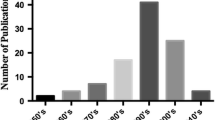Abstract
Purpose
The impact factors (IF) of orthopaedic journals is an important component in determining the future of orthopaedic research funding. We aim to characterise the trend in journal IF over the last decade and draw comparisons with other surgical specialties.
Methods
We conducted an analysis of impact factors from Journal Citation Reports between 2000 and 2010.
Results
Between 2000 and 2010 the number of orthopaedic journals increased from 24 to 41, more than any other surgical specialty and the mean IF increased from 0.842 to 1.400. Journals printed in the English language had a significantly higher IF in the year 2010 (1.64 vs. 0.33, p = 0.01) than those printed in other languages. English language journals published in the US had significantly higher mean 2010 IF (1.932 vs. 1.243, p = 0.025) than those published in Europe, and this had changed compared with 2000 mean IF (0.978 Vs. 0.704, p = 0.360). Orthopaedics was ranked sixth out of 11 surgical subspecialties in 2000 but dropped to seventh out of 11 in 2010.
Conclusions
The quality of orthopaedic journals has significantly increased over the last decade and this has been accompanied by a rise in mean IF. It is important that orthopaedics continues to improve the quality of research, which may help orthopaedic researchers secure funding in the future.





Similar content being viewed by others
References
Christenson JA, Sigelman L (1985) Accrediting knowledge: journal stature and citation impact in social science. Soc Sci Q 66(4):964–975
Garfield E (1955) Citation indexes for science; a new dimension in documentation through association of ideas. Science 122(3159):108–111
Thomson Reuters (1994) The Thomson Reuters Impact Factor. http://thomsonreuters.com/products_services/science/free/essays/impact_factor/. Accessed 08 January 2013
Isohanni M (2005) Peer review—still the well-functioning quality control and enhancer in scientific research. Acta Psychiatr Scand 112(3):165–166. doi:10.1111/j.1600-0447.2005.00601.x
Seglen PO (1997) Citations and journal impact factors: questionable indicators of research quality. Allergy 52(11):1050–1056
Seglen PO (1997) Why the impact factor of journals should not be used for evaluating research. BMJ 314(7079):498–502
Smith R (2008) Beware the tyranny of impact factors. J Bone Joint Surg Br 90(2):125–126. doi:10.1302/0301-620X.90B2.20258
Institute for Scientific Information (2012) Science citation index, journal citation reports, 1997. Institute for Scientific Information, Philidelphia, PA, USA
Chen M, Zhao MH, Kallenberg CGM (2011) The impact factor of rheumatology journals: An analysis of 2008 and the recent 10 years. Rheumatol Int 31(12):1611–1615
Postma E (2007) Inflated impact factors? The true impact of evolutionary papers in non-evolutionary journals. PLoS One 2(10):e999. doi:10.1371/journal.pone.0000999
Hakkalamani S, Rawal A, Hennessy MS, Parkinson RW (2006) The impact factor of seven orthopaedic journals: factors influencing it. J Bone Joint Surg Br 88(2):159–162. doi:10.1302/0301-620X.88B2.16983
Kurmis AP (2003) Current concepts review: understanding the limitations of the journal impact factor. J Bone Joint Surg A 85(12):2449–2454
Siebelt M, Siebelt T, Pilot P, Bloem RM, Bhandari M, Poolman RW (2010) Citation analysis of orthopaedic literature; 18 major orthopaedic journals compared for impact factor and SCImago. BMC Musculoskelet Disord 11:4. doi:10.1186/1471-2474-11-4
Bosker BH, Verheyen CC (2006) The international rank order of publications in major clinical orthopaedic journals from 2000–2004. J Bone Joint Surg Br 88(2):156–158
Hecht F, Hecht BK, Sandberg AA (1998) The journal “impact factor”: a misnamed, misleading, misused measure. Cancer Genet Cytogenet 104(2):77–81
Saper CB (1999) What’s in a citation impact factor? A journal by any other measure. J Comp Neurol 411(1):1–2
Sieck GC (2000) The “impact factor”: what it means to the impact of applied physiology. J Appl Physiol 89(3):865–866
Boldt J, Haisch G, Maleck WH (2000) Changes in the impact factor of anesthesia/critical care journals within the past 10 years. Acta Anaesthesiol Scand 44(7):842–849
Kurmis AP (2003) Understanding the limitations of the journal impact factor. J Bone Joint Surg Am 85-A(12):2449–2454
HEFCE (2009) Research Excellence Framework. Second consultation on the assessment and funding of research. http://www.hefceacuk/uk/pubs/hefce/2009/09_38/09_38pdf. Accessed 08 January 2013
HEFCE (2011) Research Excellence Framework 2014: Assessment framework and guidance on submissions. http://www.hefce.ac.uk/research/ref/pubs/2011/02_11/02_11.pdf. Accessed 08 January 2013
Association BO (2011) BOA: our research strategy. http://www.boa.ac.uk/JA/Pages/home.aspx. Accessed 19 January 2012
Bhandari M, Richards RR, Sprague S, Schemitsch EH (2002) The quality of reporting of randomized trials in The Journal of Bone and Joint Surgery from 1988 through 2000. J Bone Joint Surg Am 84-A(3):388–396
Parsons NR, Hiskens R, Price CL, Achten J, Costa ML (2011) A systematic survey of the quality of research reporting in general orthopaedic journals. J Bone Joint Surg Br 93(9):1154–1159
Singh JA, Murphy S, Bhandari M (2009) Assessment of the methodologic quality of medical and surgical clinical trials in patients with arthroplasty. J Rheumatol 36(12):2642–2654
Okike K, Kocher MS, Torpey JL, Nwachukwu BU, Mehlman CT, Bhandari M (2011) Level of evidence and conflict of interest disclosure associated with higher citation rates in orthopedics. J Clin Epidemiol 64(3):331–338. doi:10.1016/j.jclinepi.2010.03.019
Author information
Authors and Affiliations
Corresponding author
Rights and permissions
About this article
Cite this article
Moverley, R., Rankin, K.S., McNamara, I. et al. Impact factors of orthopaedic journals between 2000 and 2010: trends and comparisons with other surgical specialties. International Orthopaedics (SICOT) 37, 561–567 (2013). https://doi.org/10.1007/s00264-012-1769-1
Received:
Accepted:
Published:
Issue Date:
DOI: https://doi.org/10.1007/s00264-012-1769-1




